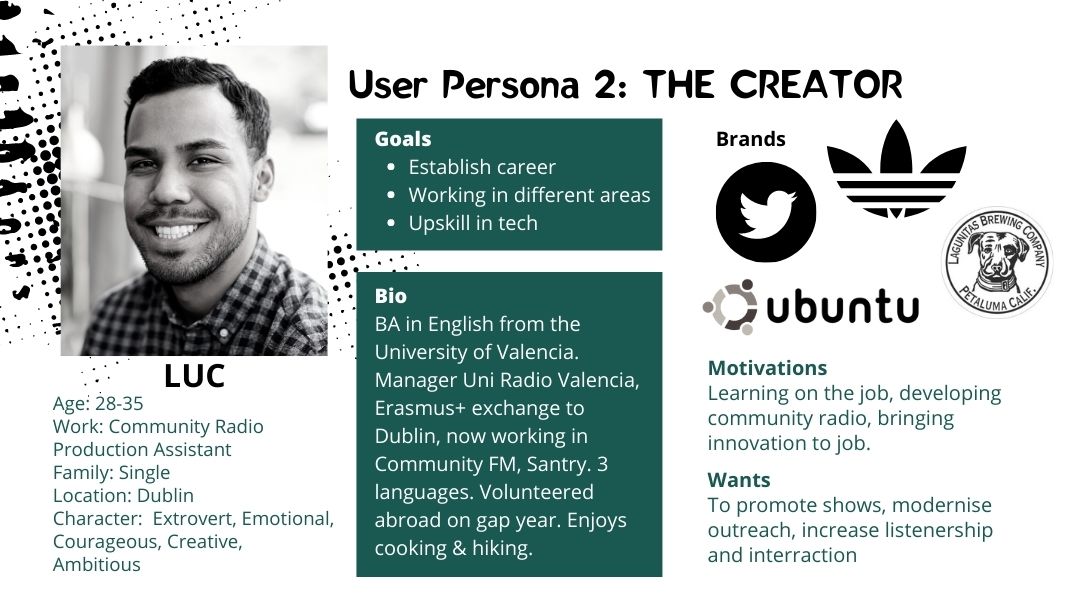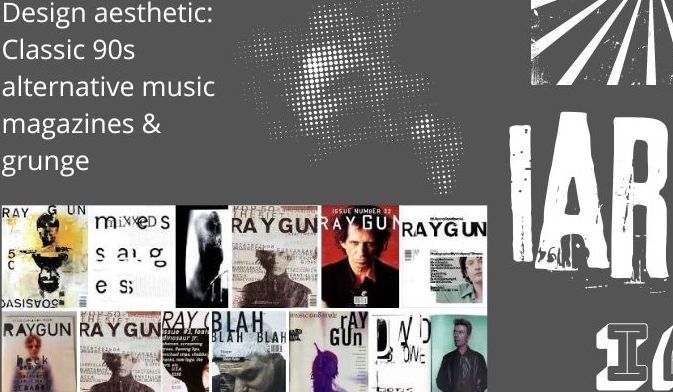Bespoken Word & Alternative Listening
IAR [Irish Alternative Radio] is a new app that combines the best of traditional, lovingly made, human-centred radio and the convenience of smart devices and always on connectivity.
Listeners
Create an account, select your favourite genres of music and we'll populate a 24/7 schedule of Irish radio programmes from Community, Digital, Commercial and National broadcasters. No live show that fits your criteria? We'll pull from previously broacast shows via RSS and Cloudcast hosts, so there's always something fresh for your ears.Creators
Create an account, populate your profile and start adding shows to the back-end scheduler. You can add conctact information, listen back RSS and logos. Add your root streaming url, and you're ready to reach new listeners. That's it!User Personae & Scenarios
I have two groups of users in mind; the listener and the content creator. This application is not aiming to be TuneIn or Spotify. It has a specific target audience of Irish music lovers that want to discover new content and support Irish producers. This may only be 200,000 people, but they are likely to be loyal, interested, media-savvy and willing to try new things.
There are three fundamental scenarios I envisage, these encompass signing up (listener and creator) and logging in and editing your schedule. Adding the IAR Skill to your smart speaker is referenced, but outside the scope of this project as each major smart speaker brand has a closed ecosystem with discrete developer requirements and toolkits.
Design Considerations
See the FAQ and Further Information Section for full design and application comparison details.
Wireframe
While the application is usable on desktop, it is designed for mobile browser and as a mobile application primarily. There is a desktop iteration in the wireframe, along with smart speaker interaction pages and smart watch.
Prototype Video
FAQ & Further Info
-
What is the main functionality of our product?
I have prototyped a web application, particularly suited to smartphone and designed for smart speaker skill integration. The smart speaker skill development is outside the scope of this assignment, but the foundations of skills for Google Home, Amazon Alexa and by extension Apple HomePod, Sonos or other smart speakers. Amazon Alexa is the most openly developed for, the others have varying levels of closed systems. The product aggregates simulcast audio streams from Irish radio stations, and switches between streams based on user-indicated preferences for genres.
-
What kind of user experiences does it offer?
This product offers a bespoke, user-tailored audio feed of live, human-made FM and digital radio. You can listen through the mobile application, mobile website or desktop and you can also listen across smart devices in the home or while travelling. Irish Alternative Radio is the first player in Ireland to champion the excellent and overlooked niche and specialist radio shows made each week by staff and volunteers of state, commercial, local, community and digital stations. It is designed to run in the background and keep the listener company, but do so with local presenters, producers, content, news, artists and musicians. The schedule is “set it and forget” unless users want to make changes to their stream feed.
-
What are the data types that the user need to interact with?
The user will primarily interact with a table of shows in their schedule, voice command and audio output.
-
What kind of interactions are there?
The primary function of the app is to play a continuous online stream of Irish-produced audio, tailored to the user. There is an initial setup with basic data and genre choces. On a granular level, users can mute shows and stations, star favourite shows, share shows and schedules and email the stations or presenters through their schedule page on the app. In addition if metadata is available from the station, the user can ask the smart speaker what song is currently playing, ask Irish alternative radio to mute a show or star a show. In addition, users can receive a smartphone, desktop or smart speaker notification that a starred show is about to come on air.
-
Does our product need internet to run? Does it rely on cloud services?
The application needs continuous internet connectivity to run. Bandwidth requirements are not a high as video streaming. Radio stations offer their streams at bitrates ranging from 96 to 320kbps, already allowing for users listening in areas with poorer internet coverage or those in transit. The user databases are hosted on cloud servers. To listen online, or on a smart speaker the application needs to fetch user data in the form of schedule, current show and streaming url. In the case that there is no live show being broadcast that matches the user preferences for genre, there is a fallback list of RSS feeds in the database of previously cloud/podcasted shows in the user’s preferred genres that will be fetched and streamed until the next live show meeting the user criteria airs. In addition to this, there may be metadata embedded in each audio stream, but this is dependent on the encoding at each creator site.
-
What kind of technologies does your product require to fully satisfy its functionality?
This product requires a multipurpose computer (Rowland et al. 30) as opposed to a smart device or sensor in order to operate. In the first instance, this would be a smartphone, but could also be a desktop, laptop, tablet or smart speaker. Each device needs to be connected to the internet and have a speaker or headphone output. In the case of the smart speaker, this also needs be conncted to the internet so that the “proprietary protocols of the OT network to the IT network” (Sinclair) can function, be this an Amazon Alexa Skill or Apple Homepod App.
-
What are the other devices and products that your product is connected to?
As mentioned above, the product can be connected into an ecosystem using a skill or application. The product can also be cast via Bluetooth onto any compatible device, or plugged physically into a speaker. Each show or schedule is sharable on social media also.
-
Irish Alternative Radio App [Essay]
Irish Alternative Radio Application
Design and Visual Aspects
I have designed a high fidelity prototype (Nunes and Pratt 128) as the visual style of the product is key to its usability, desirability, the sense of ownership for users and the idea of an alternative or niche “club” of users. I used static invitations (Scott and Neil 181) as opposed to wizards, and separated out user onboarding and preferences into a multi-page process (Scott and Neil 174) as the app is aimed at a small screen, and each page has a separate area of focus, e.g. Privacy and notifications or music genre selection.
I have designed the app as a multi-page mobile site. There are two distinct skins based on the kind of user. It is important to separate out and distinguish between the requirements of “the listener” and “the creator”.These two questions create a series of conditional states which we can then start to form some ideas on how to wireframe them. When wireframing this experience, this flow diagram can act as a guide to make sure each page or state has been captured.
Cronenwett At the design stage I thought it wise to create two different user experiences, much as I had previously seen on Film Freeway. That website had distinct visual and functional design feels for festivals and creators. In this product once the user condition is set to listeners have a black background with white text and all the appropriate controls for editing their schedule and preferences. The creators have a white background with black text and extra functionality around editing, adding and removing shows and show media.
it is easier to design for a person you have in mind than to design for a set of data. Demographic data is valuable in finding user representatives, but it doesn’t help when you’re confronted with design decisions.
Nunes and Pratt Once I had developed the user personae and scenarios the wireframing was straightforward; put myself in their shoes, ask what I would want, and attempt to deliver that. I had several iterations of the wireframing, testing and refining until the product flowed satisfactorily.
App Comparison
by understanding the specific wants of your users, you can begin to understand the different options a user has in meeting them. you can begin to define your competitors.
Nunes and Pratt I have identified TuneIn and Irish Radioplayer as direct competitors, one international and one region-specific. Both are applications, the former a smart phone, smart speaker, smart TV and desktop web application, the latter a mobile application and smart speaker skill with no desktop functionality TuneIn is a freemium multipage applications with a huge number of platforms supported. Irish Radioplayer, which is free, has only application and skill capabilities. My product would lie somewhere in between, also free, and with mobile application, skill and desktop availability. Users must be logged in to TuneIn to use all functionality, such as personalised lists. The same is true for my product and the tailored user schedules. Irish Radioplayer is on request streaming of stations, with favourite channels cached on the application. Login for TuneIn and IAR is via email or social media.
All applications are designed with a specific focus – simple that of finding the content you want and streaming it with as little fuss as possible. There are no wizards or pop-ups needed, as the process of searching and listening is uncomplicated. IAR however does guide the user from page to page during initial setup.
None of the apps have a customisable skin, all being focussed on audio and likely have the device put into a pocket, talked to or distanced from while completing other tasks. IAR is the only of the tree applications to have functionality around creation, and creators are guided through this process on multiple pages with submission buttons on each page. The unique selling points of Irish Alternative Radio are; its linking to all radio stations, not just RTÉ and Independent Commercial Stations, high levels of customisability, understated design not common in radio applications and websites and its levelling of the media play field.
Sources Cited
Cronenwett, Diane. “Interaction Design: Flow Online Class | LinkedIn Learning, Formerly Lynda.Com.” LinkedIn, 10 Mar. 2020, www.linkedin.com/learning/interaction-design-flow.
Nunes, Jason, and Andy Pratt. Interactive Design: An Introduction to the Theory and Application of User-Centered Design. 1st Ed., e-book, Rockport Publishers, 2012.
Rowland, Claire, et al. Designing Connected Products: UX for the Consumer Internet of Things. 1st ed., e-book, O’Reilly Media, 2015.
Scott, Bill, and Theresa Neil. Designing Web Interfaces: Principles and Patterns for Rich Interactions. 1st ed., e-book, O’Reilly Media, 2009.
Sinclair, Bruce. “IoT Foundations: Fundamentals Online Class | LinkedIn Learning, Formerly Lynda.Com.” LinkedIn, 23 June 2017, www.linkedin.com/learning/iot-foundations-fundamentals.
Resources
Irish Radioplayer https://radioplayer.ie/
TuneIn desktop https://tunein.com/
Contact
Paula Healy
Student in the MA in Digital Media NUI Galway 2021-22.




